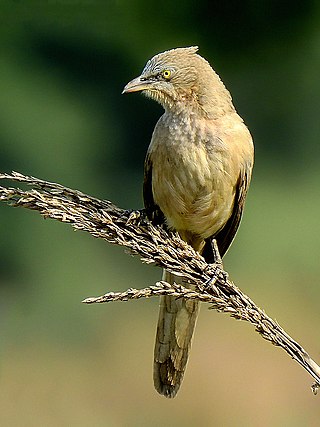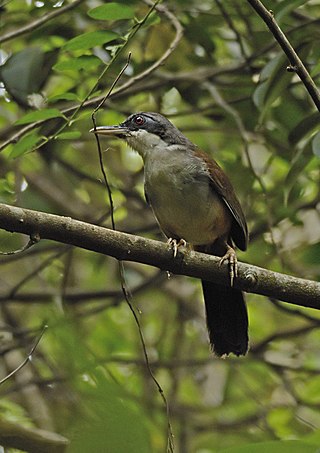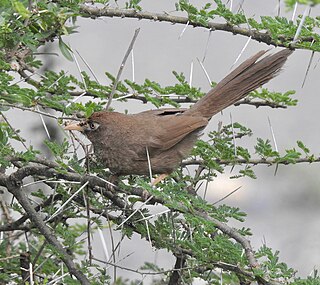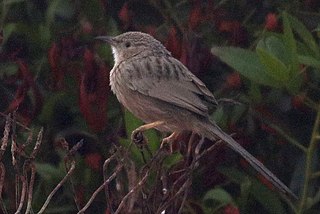
The Jacobin cuckoo, also pied cuckoo or pied crested cuckoo, is a member of the cuckoo order of birds that is found in Africa and Asia. It is partially migratory and in India, it has been considered a harbinger of the monsoon rains due to the timing of its arrival. It has been associated with a bird in Indian mythology and poetry, known as the chātaka represented as a bird with a beak on its head that waits for rains to quench its thirst.

The orange-billed babbler, also known as Ceylon rufous babbler or Sri Lankan rufous babbler, is a member of the family Leiothrichidae.

The jungle babbler is a member of the family Leiothrichidae found in the Indian subcontinent. Jungle babblers are gregarious birds that forage in small groups of six to ten birds, a habit that has given them the popular name of "Seven Sisters" in urban Northern India, and in Bengali, with cognates in other regional languages which also mean "seven brothers".

The yellow-billed babbler is a member of the family Leiothrichidae endemic to southern India and Sri Lanka. The yellow-billed babbler is a common resident breeding bird in Sri Lanka and southern India. Its habitat is scrub, cultivation and garden land. This species, like most babblers, is not migratory, and has short rounded wings and a weak flight and is usually seen calling and foraging in groups. It is often mistaken for the jungle babbler, whose range overlaps in parts of southern India, although it has a distinctive call and tends to be found in more vegetated habitats. Its name is also confused with Turdoides leucocephala, which is also known as white-headed babbler.

The ashy-headed laughingthrush is a member of the family Leiothrichidae. The laughingthrushes are a large family of Old World passerine birds characterised by soft fluffy plumage. These are birds of tropical areas, with the greatest variety in southeast Asia.

The common hawk-cuckoo, popularly known as the brainfever bird, is a medium-sized cuckoo resident in the Indian subcontinent. It bears a close resemblance to the Shikra, even in its style of flying and landing on a perch. The resemblance to hawks gives this group the generic name of hawk-cuckoo and like many other cuckoos these are brood parasites, laying their eggs in nests of babblers. During their breeding season in summer males produce loud, repetitive three note calls that are well-rendered as brain-fever, the second note being longer and higher pitched. These notes rise to a crescendo before ending abruptly and repeat after a few minutes; the calling may go on through the day, well after dusk and before dawn.

The rufous babbler is an endemic species of bird found in the Western Ghats of southern India of the family Leiothrichidae It is dark brown and long tailed, and is usually seen foraging in noisy groups along open hillsides with a mixture of grass, bracken and forest.

The large gray babbler is a member of the family Leiothrichidae found across India and far western Nepal. They are locally common in the scrub, open forest and gardenland. They are usually seen in small groups and are easily distinguished from other babblers in the region by their nasal call and the whitish outer feathers to their long tail. It is one of the largest babblers in the region.

Turdoides is a genus of passerine birds in the laughingthrush family Leiothrichidae. The species are distributed across Africa and southern Asia and are typically fairly large, long-tailed birds which forage in noisy groups. The majority of species have drab brown or grey-brown plumage. Several species that were included in Turdoides in the past have been reassigned to Argya following a 2018 study that found multiple clades.

The Arabian babbler is a passerine bird until recently placed in the genus Turdoides. It is a communally nesting resident bird of arid scrub in the Middle East which lives together in relatively stable groups with strict orders of rank.

The Wayanad laughingthrush is a species of laughingthrush in the family Leiothrichidae. It is endemic to the Western Ghats south of Goa in India. These laughingthrushes move in groups in dense forests, producing loud calls but tend to be hard to spot in the undergrowth. They have brown upperparts, a white throat, a broad black mask through the eye and a heavy bill with pale yellow on the lower mandible. Despite the name, derived from the Wayanad region, this species has a wider range than the four other south Indian species of laughingthrush that are restricted to the higher elevation hills.

The Iraq babbler is a species of bird in the family Leiothrichidae, native to reed beds of the Tigris-Euphrates Valley. It is found in Iraq and south-western Iran.

The scaly chatterer is a species of bird in the family Leiothrichidae. It is also known as the bare-eyed babbler. It is found in Ethiopia, Kenya, Somalia, and Tanzania. Its natural habitat is subtropical or tropical dry shrubland.

The striated babbler is a species of bird in the family Leiothrichidae. It is found in southern Asia from Pakistan to Myanmar.

The white-throated babbler is a species of bird in the family Leiothrichidae. It is endemic to Myanmar.

The slender-billed babbler is a species of bird in the family Leiothrichidae. It is found in Bangladesh, Nepal, Northeast India and possibly Myanmar. Its natural habitat is subtropical or tropical seasonally wet or flooded lowland grassland. It is threatened by habitat loss.

The rufous chatterer is a species of bird in the family Leiothrichidae. It is found in Ethiopia, Kenya, Somalia, Sudan, Tanzania, and Uganda. Its natural habitats are dry savanna and subtropical or tropical dry shrubland.

The Afghan babbler is a species of bird in the family Leiothrichidae. It is found from southeastern Iraq to south western Pakistan. It was formerly considered a subspecies of the common babbler.

Argya is a genus of passerine birds in the laughingthrush family Leiothrichidae. The species are distributed across Africa and southern Asia and are typically fairly large, long-tailed birds that forage in noisy groups. Members of this genus were formerly placed in the genera Turdoides and Garrulax.

The laughingthrushes are a family, Leiothrichidae, of Old World passerine birds. The family contains 133 species which are divided into 16 genera. They are diverse in size and coloration. These are birds of tropical areas, with the greatest variety in Southeast Asia and the Indian subcontinent. The entire family used to be included in the Old World babbler family Timaliidae.
























